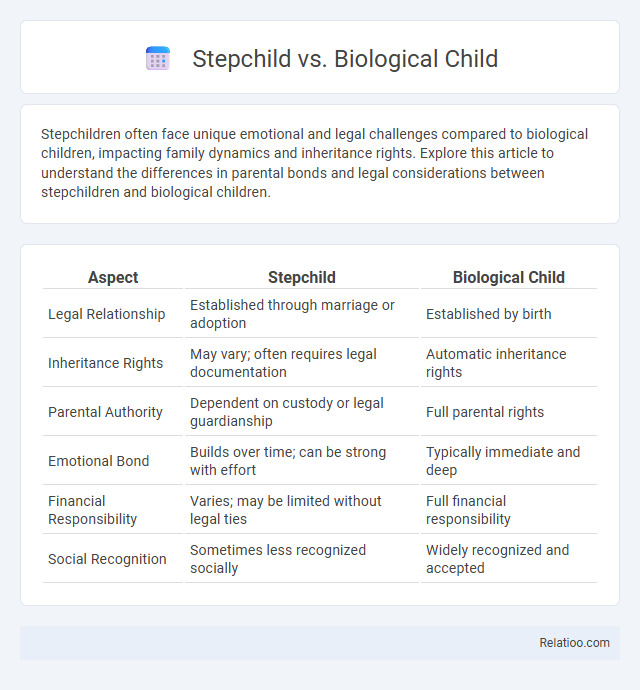Stepchildren often face unique emotional and legal challenges compared to biological children, impacting family dynamics and inheritance rights. Explore this article to understand the differences in parental bonds and legal considerations between stepchildren and biological children.
Table of Comparison
| Aspect | Stepchild | Biological Child |
|---|---|---|
| Legal Relationship | Established through marriage or adoption | Established by birth |
| Inheritance Rights | May vary; often requires legal documentation | Automatic inheritance rights |
| Parental Authority | Dependent on custody or legal guardianship | Full parental rights |
| Emotional Bond | Builds over time; can be strong with effort | Typically immediate and deep |
| Financial Responsibility | Varies; may be limited without legal ties | Full financial responsibility |
| Social Recognition | Sometimes less recognized socially | Widely recognized and accepted |
Understanding the Definitions: Stepchild vs Biological Child
A biological child is genetically related to their parents, sharing direct heredity and legal rights from birth, whereas a stepchild is related through marriage without a biological connection, often requiring legal processes like adoption for parental rights. Family role definitions vary across cultures and legal systems, shaping responsibilities, inheritance, and emotional bonds distinctly between stepchildren and biological children. Understanding these terms clarifies legal obligations and emotional dynamics within blended families, influencing guardianship, custody, and familial duties.
Legal Rights and Responsibilities
Stepchildren and biological children differ significantly in legal rights and family roles, especially regarding inheritance, custody, and support obligations. Biological children typically have established legal rights at birth, including automatic inheritance and parental responsibility, while stepchildren's rights often require formal adoption or legal agreements to ensure similar protections. Understanding your specific legal responsibilities and rights toward stepchildren is crucial to securing fair treatment and clarity within blended families.
Emotional Dynamics in Blended Families
Emotional dynamics in blended families often involve complex adjustments as stepchildren and biological children navigate loyalty conflicts, trust-building, and identity formation within shared family roles. Your ability to recognize each child's unique emotional needs and develop open communication fosters resilience and harmony despite differing attachment histories and parental bonds. Prioritizing empathy and consistent parental support bridges gaps between stepfamily members and strengthens overall family cohesion.
Challenges in Building Relationships
Stepchildren often face challenges in building relationships due to loyalty conflicts and differences in family dynamics compared to biological children, who typically have established bonds from birth. Your role as a stepparent requires patience and consistent effort to build trust and navigate complex emotions within blended families. Family roles can blur, making it essential to acknowledge individual feelings and create new traditions that foster connection and acceptance.
Parenting Approaches: Fairness and Boundaries
Parenting approaches to stepchildren versus biological children often emphasize fairness by establishing consistent boundaries that respect each child's unique family role and emotional needs. Effective strategies include clear communication, equitable discipline, and tailored affection to foster a sense of belonging while acknowledging the complexities of blended family dynamics. Balancing fairness involves recognizing biological ties without diminishing the importance of stepchildren, ensuring harmonious family relationships through structured yet empathetic parenting.
Impact on Family Structure and Roles
Stepchildren often reshape traditional family roles by introducing complex dynamics between biological parents, stepparents, and children, influencing authority and caregiving patterns within the household. Biological children typically maintain primary familial bonds and inheritance rights, which can affect resource distribution and emotional priorities in blended families. Your ability to navigate these roles and establish clear boundaries directly impacts family cohesion and the development of supportive relationships among all members.
Financial Considerations and Obligations
Stepchildren and biological children often face different financial considerations and obligations within a family structure, affecting inheritance rights, tax benefits, and support responsibilities. Your estate planning must clearly define these roles to avoid legal disputes and ensure equitable financial treatment, especially regarding trusts, wills, and Medicaid planning. Understanding the nuances of financial obligations, including child support and education funding, is crucial to fulfilling your responsibilities and protecting family assets.
Social Perceptions and Stereotypes
Stepchildren often face social perceptions shaped by stereotypes that question their belonging and loyalty within the family compared to biological children, who are frequently assumed to possess inherent bonds and privileges. Family roles are influenced by societal narratives that prioritize genetic links, leading to biases that can affect parenting dynamics, inheritance rights, and emotional support systems. Understanding these stereotypes is crucial for promoting inclusive family structures and addressing the social challenges faced by stepchildren in household roles.
Tips for Successful Blended Family Integration
Establishing clear communication and setting realistic expectations are crucial for successful blended family integration, particularly when balancing relationships between stepchildren and biological children. Fostering empathy and respect through family meetings and shared activities helps build trust and unity across diverse family roles. Consistency in parenting approaches and acknowledging the unique emotional needs of each child promote a harmonious family environment.
Long-Term Outcomes for Stepchildren and Biological Children
Long-term outcomes for stepchildren often vary from those of biological children due to differences in family role dynamics, attachment security, and access to parental resources. Research indicates that biological children typically experience more stable emotional support and consistent socialization patterns, which contribute to better academic achievement and psychological well-being. Stepchildren may face challenges such as ambiguous family roles and reduced parental investment, but positive stepfamily functioning and strong stepchild-stepparent relationships can significantly improve their developmental trajectories and overall life satisfaction.

Infographic: Stepchild vs Biological Child
 relatioo.com
relatioo.com